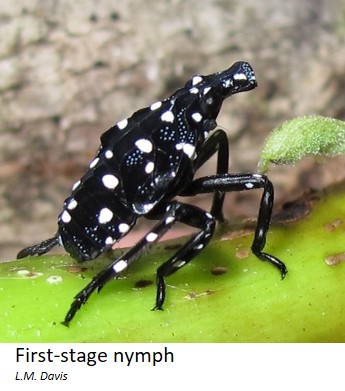
Spotted lanternfly is an insect pest introduced to the U.S. from Asia. It threatens grapes, hops, hardwoods
(especially tree-of-heaven), walnut, and maple.
It has not been found in Wisconsin. The Wisconsin
Department of Agriculture, Trade and Consumer Protection is monitoring for this pest. We need the help of business and consumers, because prevention and early detection are vital to keeping spotted lanternfly from becoming established in Wisconsin. The scientific name for SLF is
Lycorma delicatula. It is in the insect order Hemiptera and the Fulgoridae family. This makes SLF a type of true bug called a planthopper, even though it may look like a butterfly or moth to some people. Despite having four wings, SLF prefers to move by jumping rather than by flying.
Distribution

SLF is native to China, India, Japan, and Vietnam. It has also been introduced into South Korea. It was first found in the U.S. in Pennsylvania in 2014. Since that time, SLF - an excellent hitchhiker - has spread to at least 18 states, including Connecticut, Delaware, Georgia, Illinois, Indiana, Kentucky, Maryland, Massachusetts, Michigan, New Jersey, New York, North Carolina, Ohio, Rhode Island, Tennessee, Virginia, and West Virginia.
Damage
Spotted lanternfly is a sap feeder. Both the immature nymphs and the adults feed by sucking sap from the stem, branches, twigs and leaves of the host plant. This reduces the plant’s ability to photosynthesize food, weakening the plant and eventually contributing to the plant’s death. Insect feeding sites leak sap after SLF wounding, causing a fermented odor. The insects also excrete honeydew, which promotes black, sooty mold growth and attracts other insects.
Host Plants
The adult SLF prefers to feed on grapevines (Vitis vinifera) and tree of heaven (Ailanthus altissima), which is itself an invasive species. Nymphs have a wider range of hosts. They will feed on:
- Grapes and hops, both emerging as high-value agricultural crops in Wisconsin
- Roses and other important ornamental nursery crops
- Hardwoods - including maple, walnut, willow, and poplar - important to the state’s logging and paper industries
Life Cycle

 The spotted lanternfly lays eggs in fall on the host plants, but may also lay them on dead plants or on smooth surfaces like bricks, stones, and outdoor furniture, vehicles, trailers, or other items that might be moved. The eggs hatch in late spring and early summer, and the nymphs start feeding. They develop into adults after late July and continue feeding until November – not necessarily on the same host plant as the nymphs.
The spotted lanternfly lays eggs in fall on the host plants, but may also lay them on dead plants or on smooth surfaces like bricks, stones, and outdoor furniture, vehicles, trailers, or other items that might be moved. The eggs hatch in late spring and early summer, and the nymphs start feeding. They develop into adults after late July and continue feeding until November – not necessarily on the same host plant as the nymphs.
The egg masses are 1-2 inches long and look waxy and gray at first, then become hardened and cracked as the season goes on. After hatching, individual eggs are noticeable, looking like 4-7 rows of dark brown “seeds.”
The wingless nymphs that emerge from eggs are black with white spots. Later stage nymphs are red and black with white 
 spots. The adults have wings that are pinkish purple with black spots when folded. When outspread, the upper wings are white to tan, and the lower wings have distinctive red, black and white markings. The tips of both sets of wings are dark brown to black. Adults are 1 inch long and 1½ inch wide when wings are outspread.
spots. The adults have wings that are pinkish purple with black spots when folded. When outspread, the upper wings are white to tan, and the lower wings have distinctive red, black and white markings. The tips of both sets of wings are dark brown to black. Adults are 1 inch long and 1½ inch wide when wings are outspread.
Dispersal
SLF travels only short distances on its own, by walking, jumping, or flying. They are weak fliers. This is a hitchhiking insect. It moves on nursery stock, firewood, rail cars, trucks, shipping containers, bricks, stone, and other materials moved by humans. It is most likely to move as egg masses.
Reporting
If you suspect you have found spotted lanternfly, please report it immediately. If possible, take photos, and note the location.
Back to main pests and diseases page